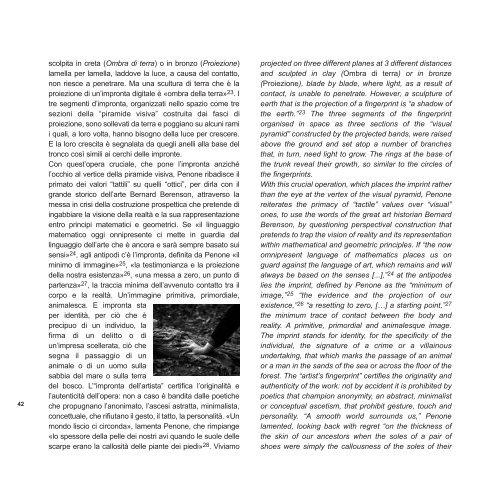Adachiara Zevi - arteinmemoria
Adachiara Zevi - arteinmemoria
Adachiara Zevi - arteinmemoria
Create successful ePaper yourself
Turn your PDF publications into a flip-book with our unique Google optimized e-Paper software.
42<br />
scolpita in creta (Ombra di terra) o in bronzo (Proiezione)<br />
lamella per lamella, laddove la luce, a causa del contatto,<br />
non riesce a penetrare. Ma una scultura di terra che è la<br />
proiezione di un’impronta digitale è «ombra della terra» 23 . I<br />
tre segmenti d’impronta, organizzati nello spazio come tre<br />
sezioni della “piramide visiva” costruita dai fasci di<br />
proiezione, sono sollevati da terra e poggiano su alcuni rami<br />
i quali, a loro volta, hanno bisogno della luce per crescere.<br />
E la loro crescita è segnalata da quegli anelli alla base del<br />
tronco così simili ai cerchi delle impronte.<br />
Con quest’opera cruciale, che pone l’impronta anziché<br />
l’occhio al vertice della piramide visiva, Penone ribadisce il<br />
primato dei valori “tattili” su quelli “ottici”, per dirla con il<br />
grande storico dell’arte Bernard Berenson, attraverso la<br />
messa in crisi della costruzione prospettica che pretende di<br />
ingabbiare la visione della realtà e la sua rappresentazione<br />
entro principi matematici e geometrici. Se «il linguaggio<br />
matematico oggi onnipresente ci mette in guardia dal<br />
linguaggio dell’arte che è ancora e sarà sempre basato sui<br />
sensi» 24 , agli antipodi c’è l’impronta, definita da Penone «il<br />
minimo di immagine» 25 , «la testimonianza e la proiezione<br />
della nostra esistenza» 26 , «una messa a zero, un punto di<br />
partenza» 27 , la traccia minima dell’avvenuto contatto tra il<br />
corpo e la realtà. Un’immagine primitiva, primordiale,<br />
animalesca. E impronta sta<br />
per identità, per ciò che è<br />
precipuo di un individuo, la<br />
firma di un delitto o di<br />
un’impresa scellerata, ciò che<br />
segna il passaggio di un<br />
animale o di un uomo sulla<br />
sabbia del mare o sulla terra<br />
del bosco. L’“impronta dell’artista” certifica l’originalità e<br />
l’autenticità dell’opera: non a caso è bandita dalle poetiche<br />
che propugnano l’anonimato, l’ascesi astratta, minimalista,<br />
concettuale, che rifiutano il gesto, il tatto, la personalità. «Un<br />
mondo liscio ci circonda», lamenta Penone, che rimpiange<br />
«lo spessore della pelle dei nostri avi quando le suole delle<br />
scarpe erano la callosità delle piante dei piedi» 28 . Viviamo<br />
projected on three different planes at 3 different distances<br />
and sculpted in clay (Ombra di terra) or in bronze<br />
(Proiezione), blade by blade, where light, as a result of<br />
contact, is unable to penetrate. However, a sculpture of<br />
earth that is the projection of a fingerprint is “a shadow of<br />
the earth.” 23 The three segments of the fingerprint<br />
organised in space as three sections of the “visual<br />
pyramid” constructed by the projected bands, were raised<br />
above the ground and set atop a number of branches<br />
that, in turn, need light to grow. The rings at the base of<br />
the trunk reveal their growth, so similar to the circles of<br />
the fingerprints.<br />
With this crucial operation, which places the imprint rather<br />
than the eye at the vertex of the visual pyramid, Penone<br />
reiterates the primacy of “tactile” values over “visual”<br />
ones, to use the words of the great art historian Bernard<br />
Berenson, by questioning perspectival construction that<br />
pretends to trap the vision of reality and its representation<br />
within mathematical and geometric principles. If “the now<br />
omnipresent language of mathematics places us on<br />
guard against the language of art, which remains and will<br />
always be based on the senses [...],” 24 at the antipodes<br />
lies the imprint, defined by Penone as the “minimum of<br />
image,” 25 “the evidence and the projection of our<br />
existence,” 26 “a resetting to zero, […] a starting point,” 27<br />
the minimum trace of contact between the body and<br />
reality. A primitive, primordial and animalesque image.<br />
The imprint stands for identity, for the specificity of the<br />
individual, the signature of a crime or a villainous<br />
undertaking, that which marks the passage of an animal<br />
or a man in the sands of the sea or across the floor of the<br />
forest. The “artist’s fingerprint” certifies the originality and<br />
authenticity of the work: not by accident it is prohibited by<br />
poetics that champion anonymity, an abstract, minimalist<br />
or conceptual ascetism, that prohibit gesture, touch and<br />
personality. “A smooth world surrounds us,” Penone<br />
lamented, looking back with regret “on the thickness of<br />
the skin of our ancestors when the soles of a pair of<br />
shoes were simply the callousness of the soles of their


